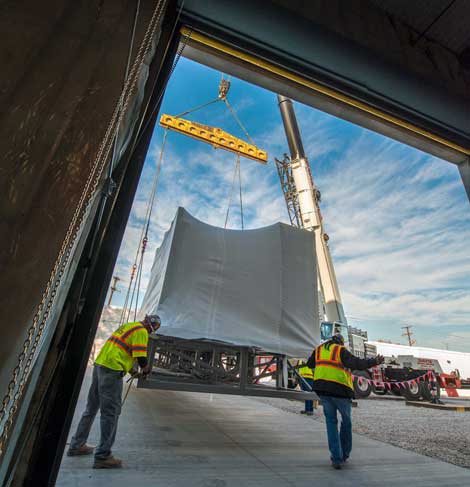
Employees of Digital Realty deliver a pre-fabricated electrical room on a skid to a data center site. The company has updated its POD architecture to make more effective use of these type of components. (Photo: Digital Realty Trust).
Digital Realty Trust has updated a key building block in its data center construction process to provide tenants with more power to support their IT infrastructure. Digital Realty, the world's largest landlord of data center properties, has introduced the next next generation of the POD Architecture for its data center halls.
The new version, known as POD 3.0, makes more effective use of pre-fabricated designs. This has allowed Digital Realty to offer customers up to 1.2 megawatts of IT capacity in each data hall, up from 1.125 megawatts. Those 75 extra kilowatts are a meaningful boost in capacity for companies with growing infrastructure.
“This new generation of POD Architecture will enable us to do more in terms of capacity and energy performance, using the same operating scale that we successfully deployed as POD 2.0,” said Jim Smith, chief technology officer at Digital Realty. “Using real-time information, we have been able to fine-tune our design and develop the next generation of our POD Architecture. We were able to demand more from the existing platform and deliver an enhanced solution to our customers in terms of performance, reliability and cost efficiency.”
Pre-Fab Components Streamline Process
The key to the improvements in the POD Architecture prcoess, Smith said, is the pre-fabrication of major electrical and mechanical systems that traditionally have played a lareg role in data center construction timelines. Pre-fabricated components are now manufactured in a factory environment and then warehoused for on-time delivery to project sites. The cooling and electrical systems are pre-commissioned in the factory and then re-commissioned along with the completed data center.
The POD 3.0 design uses just two electrical skids, compared with the three skids in POD 2.0. The reduction of the infrastructure footprint will help improve the yield on building space for data halls, allowing the increase in critical IT load capacity to 1.2 megawatts. The design retains the same cost point, but will allow customers to improve their energy efficiency, enabling Power Usage Effectiveness (PUE) ratings below 1.2.
Digital Realty's use of POD Architecture helped the company deliver 49 megawatts of data center capacity in 2012, and it expects to deliver another 89 megawatts in 2013, Smith said.
Digital Realty (DLR) operates 110 properties with approximately 21.2 million square feet of space in 32 markets throughout Europe, North America, Asia and Australia.




